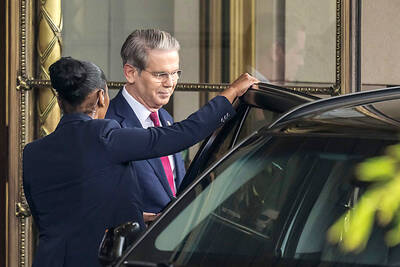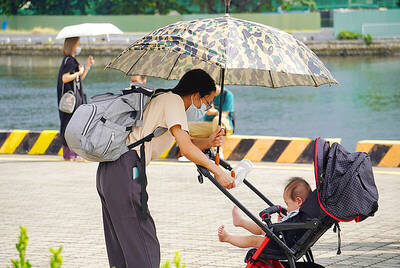The search for former Iraqi president Saddam Hussein gained fresh impetus yesterday after US soldiers killed his two sons Uday and Qusay in a fierce six-hour battle with machineguns and rockets at a villa in northern Iraq.
Celebratory shots rang out in Baghdad, but sceptical Iraqis said they wanted proof of the deaths.
Lieutenant-General Ricardo Sanchez, commander of ground forces in Iraq, said he would provide evidence to show beyond doubt that the two men had been killed when 200 soldiers backed up by helicopters attacked the villa in Mosul on Tuesday.
He told a news conference late on Tuesday that the deaths of Uday and Qusay -- tracked down after a tip-off from a walk-in informant who stands to gain at least some of the two US$15 million rewards for information on their whereabouts -- showed that Saddam himself could not hide forever.
"It confirms that we will succeed in our hunt for former regime members, and in particular Saddam Hussein, wherever they are and however long it takes," he said.
Sanchez said the killings of Uday, 39, and Qusay, two years younger, would also deal a blow to guerrillas who have staged a wave of attacks and ambushes on US forces in Iraq, claiming the lives of 39 American soldiers since President George W. Bush declared major combat over on May 1.
Paul Bremer, the US administrator of Iraq, said there was a risk of revenge attacks by Saddam loyalists.
"We could see attacks in the next few days as revenge. But you have to remember that a lot of the attacks that are taking place are being based on the idea that somehow the Saddams are coming back, that he and his sons are coming back," he said.
"Well, they're not coming back. But now two of them are dead. It won't be long before we get the father," he said.
The US has offered US$25 million for information leading to the capture or killing of Saddam.
"I think we now have a possibility of somebody coming with the big one, somebody who really wants to get the US$25 million reward," said Bremer, on a visit to the US. "It will move the day a bit closer when we get our hands on the father."
Many Iraqis still doubted Saddam's sons were dead.
"I don't believe they are dead because Saddam would never let his sons travel together," said Nasheet Chalabi, who owns a grocery shop in Mosul.
US officials have blamed die-hard Saddam loyalists for the guerrilla insurgency against American forces.
But other groups have also claimed responsibility for the attacks, distancing themselves from Saddam's secular Iraqi nationalism and embracing the Islamist, anti-American slogans of Osama bin Laden's al-Qaeda network.
A leading pro-US Iraqi politician said Qusay was behind many of the attacks on US troops. "He was in charge of the network that was causing a great deal of the trouble," Ahmad Chalabi, head of the Iraqi National Congress, told reporters.
"This is very important. This will contribute considerably to reducing attacks on coalition soldiers," he said in New York. "Both of those characters are hated figures in Iraq."
But Wamidh Nazmi, a political science professor at Baghdad University, said the killings would not end guerrilla attacks.
"I do not think that Saddam and his two sons are a very important part of the resistance ... and if they have any role it is a minimal one," he said. "So I don't think the deaths of the sons ... will affect the resistance, nor even the death of Saddam himself."
Uday and Qusay were not noticeably close in life, but they went down fighting side by side in the violent tradition of their clan. Barricading themselves into the villa, they resisted US troops for several sweltering hours.
Two other bodies removed from the villa were a grandson of Saddam and an aide of Uday.
Also see stories:
Saddam's sons: chips off the old block

Taiwanese Olympic badminton men’s doubles gold medalist Wang Chi-lin (王齊麟) and his new partner, Chiu Hsiang-chieh (邱相榤), clinched the men’s doubles title at the Yonex Taipei Open yesterday, becoming the second Taiwanese team to win a title in the tournament. Ranked 19th in the world, the Taiwanese duo defeated Kang Min-hyuk and Ki Dong-ju of South Korea 21-18, 21-15 in a pulsating 43-minute final to clinch their first doubles title after teaming up last year. Wang, the men’s doubles gold medalist at the 2020 and 2024 Olympics, partnered with Chiu in August last year after the retirement of his teammate Lee Yang

FALSE DOCUMENTS? Actor William Liao said he was ‘voluntarily cooperating’ with police after a suspect was accused of helping to produce false medical certificates Police yesterday questioned at least six entertainers amid allegations of evasion of compulsory military service, with Lee Chuan (李銓), a member of boy band Choc7 (超克7), and actor Daniel Chen (陳大天) among those summoned. The New Taipei City District Prosecutors’ Office in January launched an investigation into a group that was allegedly helping men dodge compulsory military service using falsified medical documents. Actor Darren Wang (王大陸) has been accused of being one of the group’s clients. As the investigation expanded, investigators at New Taipei City’s Yonghe Precinct said that other entertainers commissioned the group to obtain false documents. The main suspect, a man surnamed

US Secretary of the Treasury Scott Bessent and US Trade Representative Jamieson Greer began talks with high-ranking Chinese officials in Switzerland yesterday aiming to de-escalate a dispute that threatens to cut off trade between the world’s two biggest economies and damage the global economy. The US delegation has begun meetings in Geneva with a Chinese delegation led by Chinese Vice Premier He Lifeng (何立峰), Xinhua News Agency said. Diplomats from both sides also confirmed that the talks have begun, but spoke anonymously and the exact location of the talks was not made public. Prospects for a major breakthrough appear dim, but there is

The number of births in Taiwan fell to an all-time monthly low last month, while the population declined for the 16th consecutive month, Ministry of the Interior data released on Friday showed. The number of newborns totaled 8,684, which is 704 births fewer than in March and the lowest monthly figure on record, the ministry said. That is equivalent to roughly one baby born every five minutes and an annual crude birthrate of 4.52 per 1,000 people, the ministry added. Meanwhile, 17,205 deaths were recorded, resulting in a natural population decrease of 8,521, the data showed. More people are also leaving Taiwan, with net